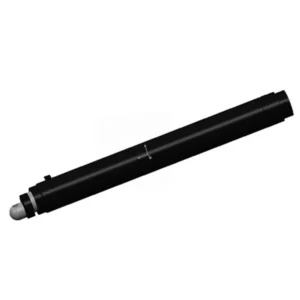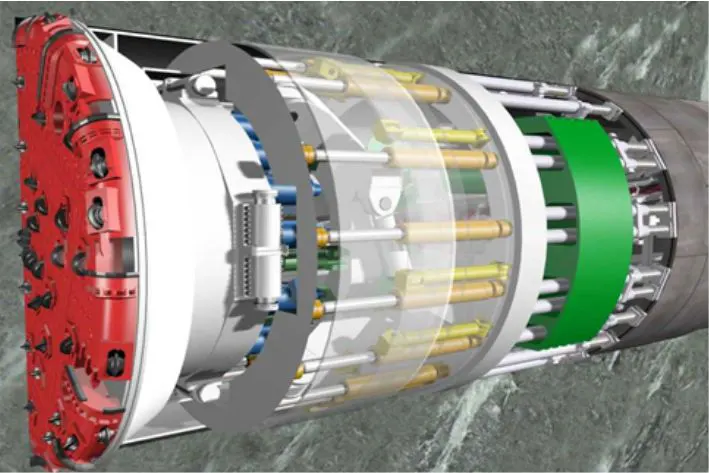Double Shield TBM Auxiliary Thrust Cylinder
Als einer der Hersteller, Lieferanten und Exporteure von mechanischen Produkten, bieten wir Hydraulikzylinder und viele andere Produkte an.
Bitte setzen Sie sich mit uns in Verbindung, um Einzelheiten zu erfahren.
Post:sales@hydraulic-cylinders.net
Hersteller, Lieferant und Exporteur von Hydraulikzylindern.
Double Shield TBM Auxiliary Thrust Cylinder

The double shield TBM auxiliary thrust cylinder is a cutting-edge hydraulic component that is vital in optimizing tunnel boring machines’ performance. This specialized cylinder is designed to provide auxiliary thrust force, supporting the main thrust cylinder and enhancing the efficiency of the tunneling process. This comprehensive article will delve into the key characteristics, usage methods, and maintenance guidelines for the double shield tbm auxiliary thrust cylinder.
The double shield TBM auxiliary thrust cylinder is a crucial component that empowers tunnel boring machines to achieve unparalleled efficiency and productivity. With its enhanced thrust support, robust construction, compact design, and precise control mechanisms, this cylinder ensures tunneling operations’ smooth and efficient advancement. By following the recommended usage methods and adhering to regular maintenance practices, the double shield tbm auxiliary thrust cylinder will continue to deliver exceptional performance, contributing to the success of tunneling projects. Embrace the power and reliability of the double shield tbm auxiliary thrust cylinder, revolutionizing tunnel boring with unmatched efficiency and effectiveness.
Double Shield TBM Auxiliary Thrust Cylinder Key Characteristics:
- Enhanced Thrust Support: The double shield auxiliary thrust cylinder is engineered to deliver exceptional auxiliary thrust support to the main thrust cylinder. By providing additional force, it ensures stable and efficient advancement of the tunnel boring machine, even in challenging ground conditions.
- Robust Construction: This cylinder features a robust and durable construction, built to withstand the demanding environments encountered during tunneling operations. Its high-quality materials and meticulous craftsmanship ensure longevity and reliability, even in the harshest conditions.
- Compact Design: The double shield TBM auxiliary thrust cylinder boasts a compact design, allowing for easy integration into the tunnel boring machine. Its space-efficient construction ensures minimal interference with other components, maximizing the overall efficiency of the tunneling process.
- Precise Control Mechanisms: Equipped with advanced control mechanisms, this cylinder offers precise and responsive operation. Operators can adjust the auxiliary thrust force according to specific ground conditions, ensuring optimal performance and minimizing the risk of disruptions.
Double Shield TBM Auxiliary Thrust Cylinder Parameter:
| Product Name | Double Shield Tunnel Boring Machine Auxiliary Thrust Cylinder |
| Features: | Relying on the reaction force of the auxiliary push cylinder to push the tube piece to make the TBM move forward |
| Bore diameter: | 220mm~320mm |
| Rod diameter: | 180mm~240mm Stroke: 2100mm~2600mm |
| Pressure: | up to 35MPa Special requirements up to 45MPa |
| Applications: | Double Shield Tunnel Boring Machine |
Double Shield TBM Cylinder Application:

Usage Method Of Double Shield TBM Auxiliary Thrust Cylinder:
- Cylinder Integration: Install the double shield tbm auxiliary thrust cylinder in the designated location within the tunnel boring machine, following the manufacturer’s guidelines and specifications. Ensure proper alignment and secure attachment to the tbm’s structure using suitable mounting brackets or accessories.
- Hydraulic System Integration: Connect the cylinder to the TBM’s hydraulic system using compatible hoses and fittings. Verify that all connections are secure, leak-free, and properly tightened to ensure optimal hydraulic performance.
- Control and Operation: Familiarize yourself with the TBM’s control system and the specific controls associated with the double shield tbm auxiliary thrust cylinder. Utilize these controls to activate, regulate, and monitor the auxiliary thrust force, adjusting it to match the requirements of the tunneling process and ground conditions.
- Monitoring and Adjustment: Continuously monitor the performance of the double shield tbm auxiliary thrust cylinder and the overall behavior of the tunnel boring machine. Make necessary adjustments to the auxiliary thrust force, taking into account ground conditions, geological variations, and other factors that may impact the tunneling process.
How To Change A Seal On A Hydraulic Cylinder?
Before starting, ensure you have the necessary tools, replacement seals, and a clean working area. Additionally, follow safety precautions to avoid accidents, such as relieving system pressure.
- Prepare the Cylinder:
- Disconnect the hydraulic cylinder from the system and ensure it is depressurized.
- Clean the exterior of the cylinder to prevent dirt or debris from entering during disassembly.
- Place the cylinder on a stable work surface and secure it using clamps or a vise.
- Remove the Retaining Components:
- Identify the retaining components that secure the cylinder head or cap, such as bolts or snap rings.
- Use the appropriate tools (wrenches, sockets, pliers) to loosen and remove these retaining components.
- Set aside the components in a safe place for reassembly.
- Separate the Cylinder Components:
- Gently tap the cylinder head or cap using a soft mallet to break any seal or adhesive bond.
- Slowly and carefully remove the cylinder head or cap, exposing the piston and seal.
- Pay attention to any shims, spacers, or other components present and remove them for later reassembly.
- Remove the Old Seal:
- Inspect the old seal for any damage or wear and identify the type of seal used.
- Depending on the seal type, you may need to use seal removal tools (picks, hooks) or carefully pry it out using a flat-blade screwdriver.
- Take note of the seal orientation for proper installation of the new seal.
- Clean and Inspect:
- Thoroughly clean the cylinder bore, piston, and surrounding components using a lint-free cloth or solvent appropriate for your hydraulic system.
- Inspect all components for any signs of damage, wear, or scoring. Replace any worn or damaged parts as necessary.
- Install the New Seal:
- Lubricate the new seal with hydraulic fluid or a compatible seal lubricant.
- Carefully position the new seal in the seal groove or on the piston, ensuring it is properly oriented as noted during seal removal.
- Use a seal installation tool or a soft mallet to gently press the seal into place, ensuring it is seated correctly and evenly.
- Reassemble the Cylinder:
- Reinstall shims, spacers, or other components removed during disassembly.
- Carefully align the cylinder head or cap with the cylinder body and guide the piston through it.
- Apply a suitable thread sealant or thread-locking compound to the retaining components and reattach them securely.
- Follow the manufacturer’s torque specifications for tightening the retaining components to ensure proper sealing and alignment.
- Test and Verify:
- Reconnect the hydraulic cylinder to the system and ensure all connections are secure.
- Gradually restore system pressure, checking for any leaks or abnormal behavior.
- Fully cycle the hydraulic cylinder to confirm proper operation and seal integrity.
Fähigkeit und Kapazität der Fabrik:
(1) Montage
We have a first-class independent research and development assembly platform. The hydraulic cylinder production workshop has four semi-automatic lifting cylinder assembly lines and one automatic tilt cylinder assembly line, with a designed annual production capacity of 1 million pieces. The special cylinder workshop is equipped with various specifications of a semi-automatic cleaning assembly system with a designed annual production capacity of 200,000 and equipped with famous CNC machining equipment, a machining center, a high-precision cylinder processing special equipment, a robot welding machine, an automatic cleaning machine, automatic cylinder assembly machine, and automatic painting production line. Existing critical equipment of more than 300 sets (sets). The optimal allocation and efficient use of equipment resources ensure the accuracy requirements of products and meet the high-quality needs of products.


(2) Bearbeitungen
Die Bearbeitungswerkstatt ist mit einem maßgeschneiderten Schrägschienen-Drehzentrum, einem Bearbeitungszentrum, einer Hochgeschwindigkeits-Honmaschine, einem Schweißroboter und anderen zugehörigen Geräten ausgestattet, die die Bearbeitung von Zylinderrohren mit einem maximalen Innendurchmesser von 400 mm und einer maximalen Länge von 6 Metern ermöglichen.

(3) Schweißen

(4) Malerei und Beschichtung
Mit kleinen und mittleren Zylinder automatische Lackieranlagen auf Wasserbasis, zu erreichen automatische Roboter Be-und Entladen und automatische Spritzen, die Design-Kapazität von 4000 Stück pro Schicht;
Wir verfügen auch über eine halbautomatische Lackieranlage für große Zylinder, die von einer Energiekette angetrieben wird und eine Kapazität von 60 Kisten pro Schicht hat.


(5) Prüfung
Wir verfügen über erstklassige Prüfeinrichtungen und Prüfstände, um sicherzustellen, dass die Leistung des Zylinders den Anforderungen entspricht.

We are one of the best hydraulic cylinder manufacturers. We can offer comprehensive hydraulic cylinders. We also provide corresponding landwirtschaftliche Getriebe. We have exported our products to clients worldwide and earned a good reputation because of our superior product quality and after-sales service. We welcome customers at home and abroad to contact us to negotiate business, exchange information, and mit uns zusammenarbeiten!
Machen Sie einen Rundgang durch unsere VR-Fabrik:
Machen Sie eine Tour durch unsere VR-Fabrik mit den folgenden
Wie funktioniert der Hydraulikzylinder für Gabelstapler?
Hydraulischer Zylinder Anwendung:


